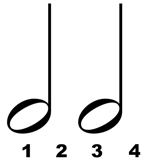In this guitar lesson we’re going to continue our rhythmic journey by tackling half notes. Like the whole notes we looked at in the last lesson, half notes are another vital note value that you need to understand.
So what exactly are they?
If you’ll remember from the lesson on whole notes, a whole note is a note that lasts for four beats. This is important to know because, as you probably can guess from its name, a half note lasts for half the length of a whole note. So this means that a half note is a note that lasts for two beats. Here’s what one looks like…
 As you can see on the left, the symbol for a half note looks very similar to that of a whole note. But notice how there is a “tail” attached to it. (This is the surest way of distinguishing a half note from a whole note).
As you can see on the left, the symbol for a half note looks very similar to that of a whole note. But notice how there is a “tail” attached to it. (This is the surest way of distinguishing a half note from a whole note).
I need to mention here that the tail won’t always be on the right hand side of the note head. (The note head is the oval part of the symbol). This means that you’ll sometimes encounter half notes that look like this…
 Notice how this version of the symbol has the tail attached to the left hand side of the note head. (You might want to check out some music books you own to see examples of this).
Notice how this version of the symbol has the tail attached to the left hand side of the note head. (You might want to check out some music books you own to see examples of this).
Don’t be thrown by how different it looks, because it still means the same thing. (A note that lasts for two beats).
Half Note Timing Exercise
Now that we’ve checked out the symbol for half notes, let’s look at a really good exercise for practising them…

This exercise is very similar to the one you practised in the last lesson. Except this time you’ll be playing two notes every four beats. Here’s how to practice it…
- Choose a single note on your guitar to play.
- Turn your metronome on and set it to 60 bpm.
- Using all downstrokes, play the note you chose in the first step. Because you’re play half notes, you’ll need to make each note last for two beats. (The first half note will be played on beat 1, while the second half note will be played on beat 3).
- Play the note repeatedly using half notes for at least a couple of minutes.
To benefit the most from this exercise you should tap your foot to the metronome click, and also count the beats out aloud. It would also be very helpful to record yourself playing the exercise. This will allow you to more accurately judge how rock-solid your timing was as you did the exercise.
Half Note Chord Progression
It’s probably a good idea if we look at a more musical way of practising half notes. Here’s a chord progression that I’d like you to practice…

If you learned the progression in the lesson on whole notes, then you’re probably feeling like you’re suffering from déjà vu! The chord progression shown above uses the exact same chords, in the exact same order. But this time most of the chords are being played using half notes. This has a couple of major implications…
- The entire chord progression now lasts for a total of only 20 beats. (The one in the last lesson lasted for a whopping 36 beats).
- The chord progression has a totally different feel when played as half notes rather than whole notes. In my opinion, it has a greater sense of urgency to it.
A Few Last Words
That’s all for this lesson. Work hard at this stuff, because next time we’re going to be taking a look at quarter notes.
Have fun!
Return To: Guitar Music Theory Lessons